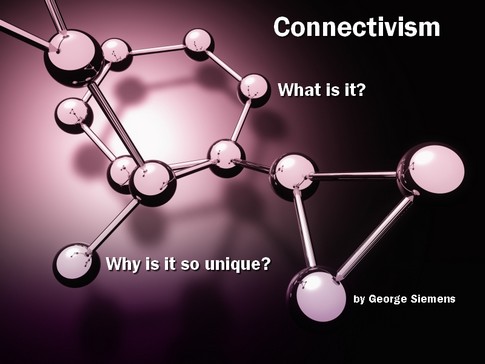What is Connectivism?
 Connectivism is a learning theory promoted by Stephen Downes and George Siemens. Called a learning theory for a digital age, it seeks to explain complex learning in a rapidly changing social digital world. In our technological and networked world, educators should consider the work of thinkers like Siemens and Downes. In the theory, learning occurs through connections within networks. The model uses the concept of a network with nodes and connections to define learning. Learners recognize and interpret patterns and are influenced by the diversity of networks, strength of ties and their context. Transfer occurs by connecting to and adding nodes and growing personal networks. (Connectivism Wikiversity)
Connectivism is a learning theory promoted by Stephen Downes and George Siemens. Called a learning theory for a digital age, it seeks to explain complex learning in a rapidly changing social digital world. In our technological and networked world, educators should consider the work of thinkers like Siemens and Downes. In the theory, learning occurs through connections within networks. The model uses the concept of a network with nodes and connections to define learning. Learners recognize and interpret patterns and are influenced by the diversity of networks, strength of ties and their context. Transfer occurs by connecting to and adding nodes and growing personal networks. (Connectivism Wikiversity)
According to George Siemens, "Connectivism is the integration of principles explored by chaos, network, and complexity and self-organization theories. Learning is a process that occurs within nebulous environments of shifting core elements – not entirely under the control of the individual. Learning (defined as actionable knowledge) can reside outside of ourselves (within an organization or a database), is focused on connecting specialized information sets, and the connections that enable us to learn more are more important than our current state of knowing. Connectivism is driven by the understanding that decisions are based on rapidly altering foundations. New information is continually being acquired. The ability to draw distinctions between important and unimportant information is vital. The ability to recognize when new information alters the landscape based on decisions made yesterday is also critical."
Siemen's Principles of connectivism:
- Learning and knowledge rests in diversity of opinions.
- Learning is a process of connecting specialized nodes or information sources.
- Learning may reside in non-human appliances.
- Capacity to know more is more critical than what is currently known
- Nurturing and maintaining connections is needed to facilitate continual learning.
- Ability to see connections between fields, ideas, and concepts is a core skill.
- Currency (accurate, up-to-date knowledge) is the intent of all connectivist learning activities.
- Decision-making is itself a learning process. Choosing what to learn and the meaning of incoming information is seen through the lens of a shifting reality. While there is a right answer now, it may be wrong tomorrow due to alterations in the information climate affecting the decision. (Connectivism: A Learning Theory for the Digital Age)
According to Siemens, learning is no longer an individualistic activity. Knowledge is distributed across networks. In our digital society, the connections and connectiveness within networks lead to learning. Siemens and Downes have experimented with Open Courses and both stress the importance of more open education. See Siemens discussing the importance of connections and connectiveness in open social learning below to the left and see the Networked Student to the right.
Siemen's on Connectivism
To read more, see Siemens blogs: elearnspace and Connectivism and Stephen Downes website Stephen's Web
In a 2010 Cisco Report called The Learning Society, the authors make the point that educational systems need to move towards becoming a Learning Society. They see the world becoming more interdependent, technology accelerating and education as a mission critical key. They feel there is a new "morality of learning." "Whereas in the past learning was competitive, coercive and paternalistic, the new ethic of learning is collaborative, global and universal. It is collaborative in that learners need to work with each other. It is global in the sense that every society has a contribution to make and a responsibilty to each other. And it is universal because every part of a society must invest in learning and participate." (The Learning Society) The future is connected and collaborative.
See Elements of Connectivism from Stephen Downes and Connectivism and Personal Learning
The Networked Student
Next up, 21st Century Learning
